#robe à l’anglaise
Text


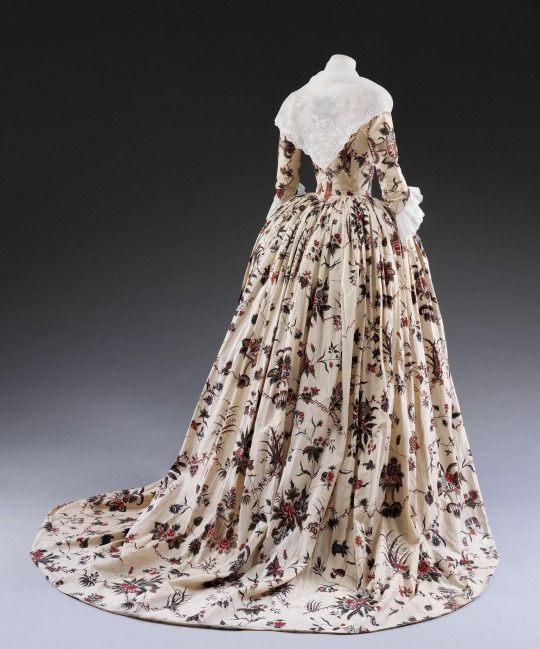
Beige Floral Cotton Robe à l’Anglaise, ca. 1760-1770, Indian (for the European Market).
Victoria and Albert Museum.
#robe à l’anglaise#womenswear#extant garments#dress#Cotton#Indian#1780s India#floral#V&A#1760#1760s#1760s dress#1760s India#1760s extant garment
212 notes
·
View notes
Text

Robe a l'anglaise, 1745
22 notes
·
View notes
Text
"Mrs Washington sends home a Green Sack to get cleand, or fresh dyed of the same colour—made up into a handsome Sack again woud be her choice, but if the Cloth wont afford that, then to be thrown into a genteel Night Gown."
George Washington to Robert Cary & Company 28 September 1760
Ordering goods from Great Britain through the London based merchant house Robert Cary and Company, George inclosed his wife’s dress to be dyed and sewn again into a sack (Robe à la Française) or into a Night Gown, which is an 18th century term for Robe à l’Anglaise.
This is interesting as this letter implies that the Washingtons could not find a suitable mantua-maker in Virginia to refashion the gown. Instead Martha preferred to send her dress to England, which could take various months arrive back. Washington’s previous two orders had taken six months and ten months. This demonstrates how dependent the then British colonies were on products from their mother country.
In early August 1761, after ten months, Martha received her newly dyed gown, which had been sewn into a sack again, back.
#martha washington#george washington#historical fashion#18th century fashion#Robe à la Française#robe à l’anglaise
29 notes
·
View notes
Photo

Robe à l’anglaise ca. 1785
From the Museum of Vancouver
667 notes
·
View notes
Photo



Robe à l’anglaise
c.1783
England; Fabric exported from India
Royal Ontario Museum (Object number: 969.85.5)
#robe a l'anglaise#fashion history#historical fashion#1780s#georgian era#georgian fashion#rococo era#18th century#red#blue#floral#flower print#chintz#cotton#india#royal ontario museum#popular
1K notes
·
View notes
Text
Dress, c.1760, silk brocaded taffeta, England.
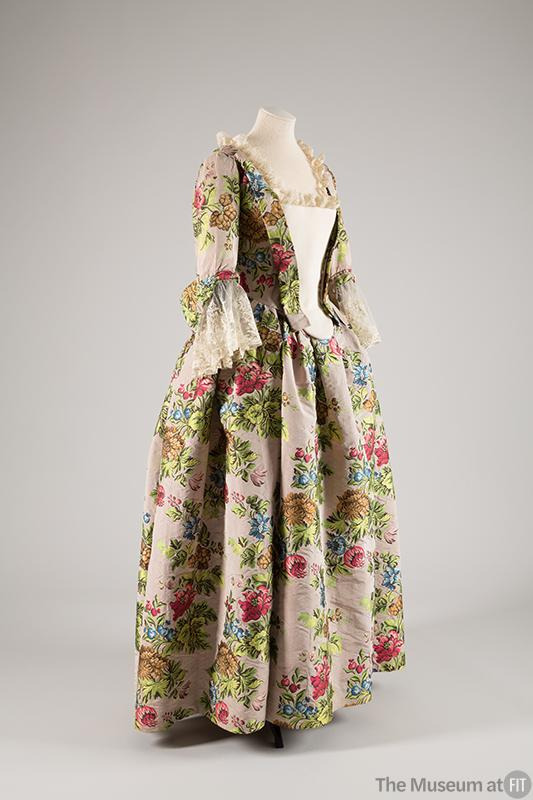


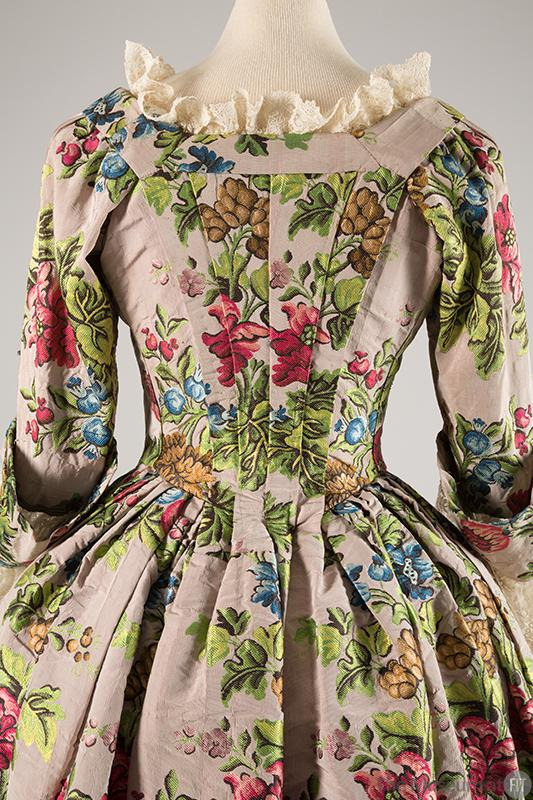
This circa 1760 gown emphasizes that the basic silhouette of women’s fashion had not changed significantly since the late seventeenth century, but by varying a gown���s textiles, colors, trims, and motifs—all showcased on expansive skirts—one could keep current with fashion. This gown’s colorful brocade fabric was likely handwoven on a complex draw loom in Europe. Yet the silhouette, rather than its costly silk, is what indicates its degree of formality. The robe à l’anglaise, distinguished by wide pleats stitched down at the center back, evoked life in an English country house and was worn in more relaxed social settings.
The Museum at FIT.
464 notes
·
View notes
Photo
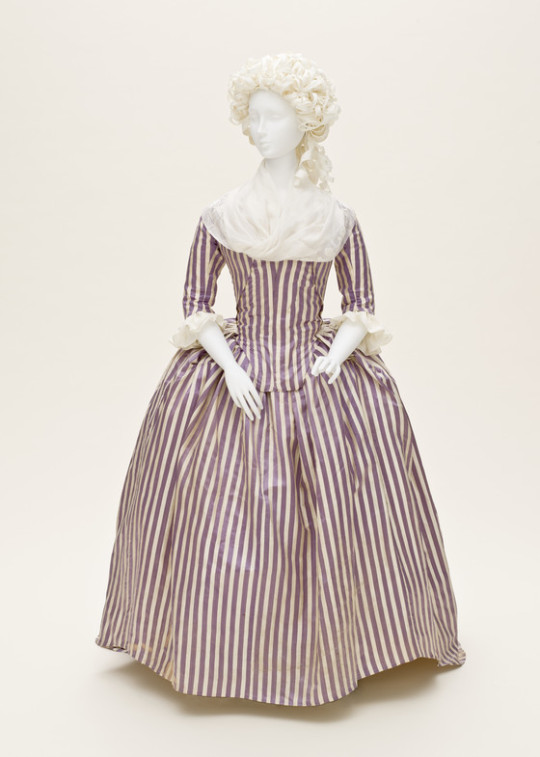
Robe à l’Anglaise
1780s
The Los Angeles County Museum of Art
Purple means spirit.
Central Florida Emergency Trans Care Fund
Equality Florida
ACLU Florida
Tampa Bay Abortion Fund
89 notes
·
View notes
Note
Fic title ask:
For All The Tea In China
The Dressmaker's Dilemma
@jomiddlemarch thank you for these. Such a fun diversion for a dull Saturday afternoon. Both my titles are Poldark based.
“For All the Tea in China”
Upset by what she understands to be a snub by Ross, Demelza returns to her place–and finds her resolve–in the kitchen.
Snippet: “Fuck it. We’re having the rapini for dinner!” Demelza said aloud to nobody and slammed the slightly wilted bunch down on the work surface.
Dinner was hours away–in fact she was still preparing lunch–but this decision felt like an act of defiance, and that was precisely what she was in need of at the moment.
Ross, or Mister Poldark as he was to her today, disliked rapini. He hadn’t said it in so many words but the absence of praise the last time she served it allowed her to solve for x.
--AND---
“The Dressmaker's Dilemma” (also Poldark but not a modern AU).
Mistress Trelask, respected Truro dressmaker, stares down a very grave problem indeed. She has taken an order from Mrs. Francis Poldark for a lovely robe à l’anglaise of soft brown silk taffeta with sleeve ruffles and matching silk ribbons. But she has only now learned that her daughter, Miss Florence, has already fitted Mrs. John Treneglos for a quite similar gown (only fewer ruffles and no fichu). And both are to be ready in time for the upcoming ball at Place House.
Mistress Trelask must now decide which patron to disappoint while protecting her own reputation.
Snippet: No doubt, she’d lose the patronage of one of these fine ladies. And who might blame them? Such an insult to one’s standing to be jilted by a dressmaker! But on the one hand, there had been very few visits of late from Mrs. Poldark (soon to be Mrs. George Warleggan if the rumours are to be believed). And wasn’t it odd that she’d come out of mourning so soon?
13 notes
·
View notes
Photo

Le Petit écho de la mode, no. 21, vol. XLV, 27 mai 1923, Paris. Au Champ de Courses. Ville de Paris / Bibliothèque Forney
Robe en linon brodée à l’anglaise et de jours Richelieu. Forme kimono à corsage plat.
Taille demi-longue, serrée dans une ceinture de ruban. Jupe froncée et brodée, terminée par un feston. Petit chapeau en velours noir, orné de fleurs et d’un voile de tulle illusion.
Dans ce numéro commence: En suivant l'étoile... roman de Florence Barclay.
#Le Petit écho de la mode#20th century#1920s#1923#periodical#cover#color#fashion#fashion plate#retouch#Forney#dress#parasol#embroidery
57 notes
·
View notes
Text

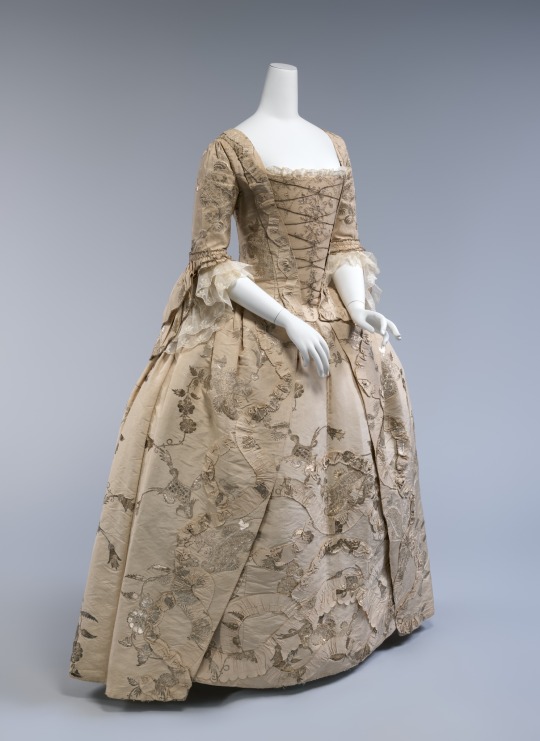
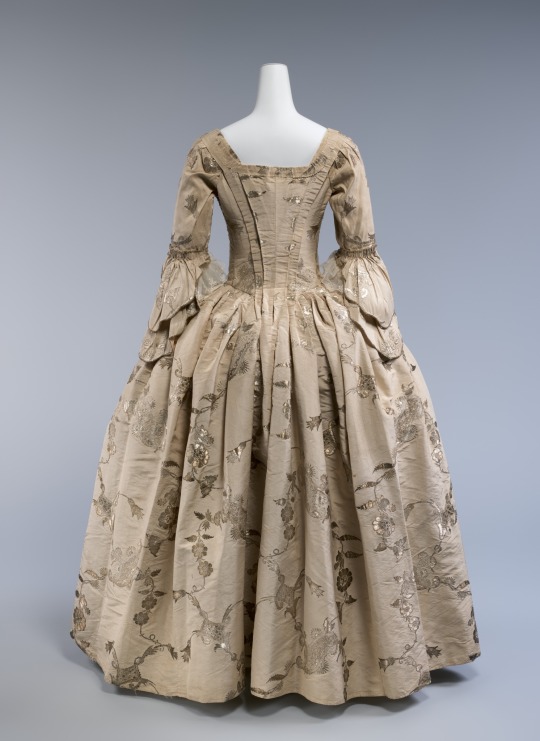
Beige Silk Robe à l’Anglaise, ca. 1747 (altered 1770s), British.
Met Museum.
#beige#silk#extant garments#womenswear#dress#1747#1770s#1740s#1740s dress#1770s dress#1740s britain#1770s britain#1740s extant garment#1770s extant garment#british#met museum#robe à l’anglaise
161 notes
·
View notes
Text
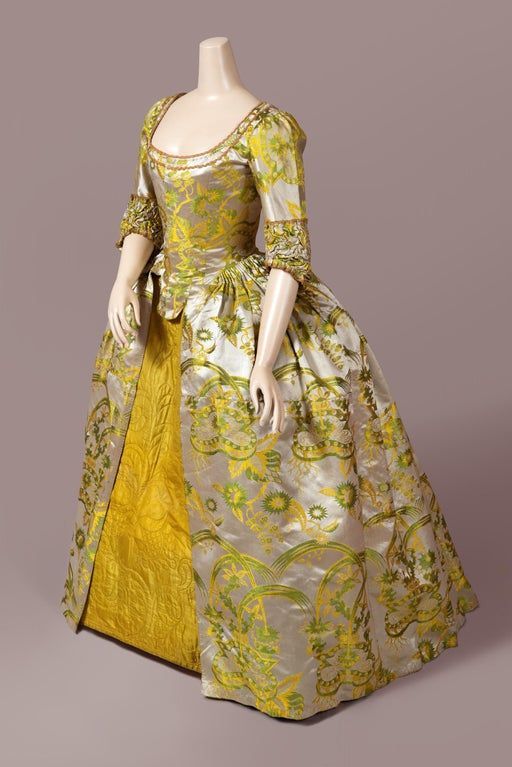

Robe à l’anglaise ca. 1775, recycled material from the early 1700s.
293 notes
·
View notes
Text
Robe à la polonaise

A woman’s garment of the later 1770s and 1780s or a similar revival style of the 1870s inspired by Polish national costume, consisting of a gown with a cutaway, draped and swagged overskirt, worn over an underskirt or petticoat. From the late 19th century, the term polonaise also described a fitted overdress which extended into long panels over the underskirt, but was not necessarily draped or swagged. As earlier as the 1720s, English painters begun to portray fashionable ladies dressed in romanticized versions of the costume of a century earlier, as depicted in portraits by van Dyck and Rubens, while French Queen Marie Leszczyńska made the Polish dress popular in that decade. By the 1770s, elements of this style began to appear in fashionable dress, including the wide-brimmed hat (dubbed the “Rubens hat” in the Fashionable Magazine of 1786) and bunched-up skirts. About the same time, French fashion adopted a number of styles of English origin, such as the robe à l’anglaise, and the fullness of the skirts at the back waist and over the hips. One way to “create the fashionable bulk at the back and sides of the dress was to kilt up the overskirt by means of interior or exterior loops, buttons or tassels to form swags of material. This style...was known as à la polonaise.
16 notes
·
View notes
Text
I had an idea to promote different costubers, where I made up a little form thing and people can comment with their favourite people to help others find channels they might be interested in. (Also if anyone here is a costuber, promo yourself!) I’ll properly add on my recommendations later but for now I’ll just do Bernadette Banner as an example since everyone knows her.
Name of channel: Bernadette Banner
Eras/types of clothes: mostly Victorian and Edwardian, but a bit of everything of Western women’s clothes from medieval to vintage, not often cosplay
Educational: very!
Instructional: yes
Additional notes: very aesthetic and well-produced
I’m thinking that educational is sort of “here is what the clothing was at the time” “this is the difference between robe à l’anglaise and robe �� l’italienne,” etc., whereas instructional is step-by-step directions to help you recreate what they are doing. So a pattern-maker’s video would be incredibly instructional, but Nicole Rudolph’s videos aren’t so much, but they are incredibly educational where a pattern-maker’s wouldn’t be.
Here’s a copy-and-paste version:
Name of channel:
Eras/types of clothes:
Educational:
Instructional:
Additional notes:
13 notes
·
View notes
Photo
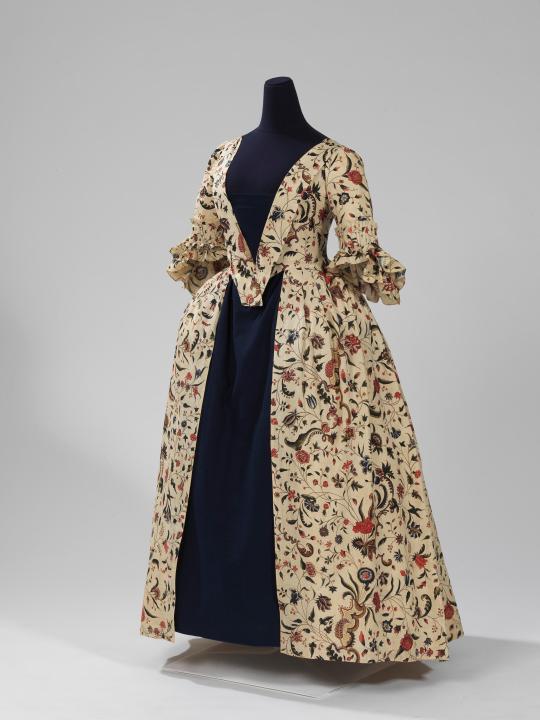


Robe à l’anglaise
c.1740-1749
England; Fabric from India
Royal Ontario Museum (Object number: 967.176.1)
#robe a l'anglaise#fashion history#historical fashion#1740s#georgian#georgian fashion#england#floral#flower print#cotton#chintz#india#off white#1740#1745#1749#18th century#royal ontario museum
476 notes
·
View notes
Text
Robe à l’anglaise, 1770′s.
Kerry Taylor Auctions.
A Chinese painted silk robe l'Anglaise, 1770s, painted with shades of blue convolvulus trails, orange honeysuckle, purpled pink posies, with fitted back, closed front bodice panels, the skirt with original pocket slits.
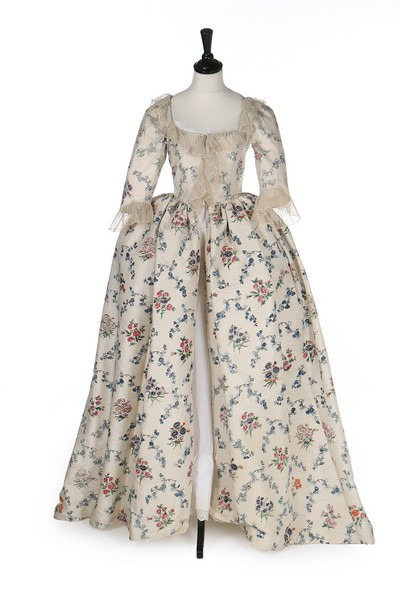





#georgian fashion#georgian era#georgian#18th century#fashion history#historical fashion#historical costume#historical costuming
89 notes
·
View notes
Video
youtube
Liked on YouTube: Dress Historian Reviews AI Generated “Historical” Portraits || https://www.youtube.com/watch?v=nZ21HIJDHAA || Get your first purchase from Blueland for 15% off by clicking my link https://ift.tt/GhW1qaA! Thanks again to Blueland for sponsoring this video ⤠ START YOUR HAND SEWING JOURNEY ⤟ 📚 BOOK: “Make, Sew and Mend: Traditional Techniques to Sustainably Maintain and Refashion Your Clothes” https://ift.tt/drHY3ti 🧵 SKILLSHARE CLASS: “Hand Sewing Basics: Working Wonders with Fabric, Needle & Thread”. To sign up for a free trial and take the class, visit https://ift.tt/PEB7oS3 ⤠ NEVER MISS AN UPDATE ⤟ 📜 (FREE) NEWSLETTER https://ift.tt/3G2He4k 📸 INSTAGRAM @bernadettebanner https://ift.tt/Jlz9Ggy ♥️ PATREON https://ift.tt/eJqITRp RESEARCH ASSISTANT | Heathcliff McLean IG @mxheathcliff https://ift.tt/Vhw0PcU EDITOR | @DannyBanner IG @danbanstudio https://ift.tt/9LIck5v This channel is made possible through the generous support of Patreon members. On behalf of myself and the team: thank you! ✨ ⤠ NOTES ⤟ [1] Follower of Hans Eworth. 1560. Portrait of a Lady, Aged 24, Small Half-Length, in a Black Fur-Trimmed Dress and White Ruff. Oil on Panel. Private collection. bit.ly/3P1EvPo. [2] Moroni, Giovanni Battista. c.1560. Woman in a Red Dress. Oil on Canvas. Dresden, Germany. Staatliche Kunstsammlungen Dresden. bit.ly/3qv03d3. [3] Van Cleve, Joos. c.1530-5. Henry VIII (1491-1547). Oil on Panel. United Kingdom. Royal Collection Trust. bit.ly/43sAqIs. [4] Veneto, Bartolomeo. 1520. Portrait of a Gentleman. Oil on Panel Transferred to Canvas. Washington, D.C. National Gallery of Art. bit.ly/43sABU8. [5] Lyon, Corneille de. 1537. Mary of Guise, 1515-1560. Queen of James V. Oil on Panel. Edinburgh, Scotland. Scottish National Portrait Gallery. bit.ly/3MWTV4U. [6] Allori, Alessandro. 1560. Portrait of a Lady. Oil on Panel. San Diego, CA. San Diego Museum of Art. bit.ly/43uzZO1. [7] Holbein the Younger, Hans. 1537. Portrait of Henry VIII. Oil on Panel. Madrid, Spain. Thyssen-Bornemisza Museum. bit.ly/45RRitQ. [8] Lyon, Corneille de. c.1560-5. Portrait of Madame de Châtillon. Oil on Panel. Indianapolis, IN. Newfields. bit.ly/45XDPRs. [9] Eworth, Hans. 1563. Portrait of a Lady of the Wentworth Family (Probably Jane Cheyne)Date: Oil on Panel. Chicago, IL. Art Institute Chicago. bit.ly/3P1EPxA. [10] Dyck, Anthony van. c.1618. Portrait of a Man. Oil on Wood. New York, NY. Metropolitan Museum of Art. bit.ly/3oRLkIR. [11] Rubens, Peter Paul. c.1617-1628. George Villiers (1592–1628), 1st Duke of Buckingham. Oil on Panel. Glasgow, Scotland. Pollok House. bit.ly/3oT7Pgm. [12] English School, 16th century. 1588. Elizabeth I, 1533-1603 (the “Armada Portrait”). Painting. London, United Kingdom. Royal Museums Greenwich. bit.ly/42x0EbD. [13] British School, 17th Century. 1675. Charles II Presented with a Pineapple. Oil on Canvas. United Kingdom. Royal Collection Trust. bit.ly/3J3k7ts. [14] Netscher, Caspar. 1669. Portrait of Susanna Doublet Huygens. Oil on Panel. New York, NY. The Leiden Collection. bit.ly/3J4na4M. [15] Winterhalter, Franz Xaver. 1865. Kaiserin Elisabeth in Balltoilette Mit Diamantsternen Im Haar. Oil on Canvas. Vienna, Austria. Kunsthistorisches Museum. bit.ly/3J2KKPj. [16] Robe à L’Anglaise. 1785. Cotton, Baleen. New York, NY. Metropolitan Museum of Art. bit.ly/3NmBOXI. [17] Court Dress. 1750. Silk, Metallic Thread. New York, NY. Metropolitan Museum of Art. bit.ly/2PhktSc. [18] Circle of Johann Heinrich Tischbein. 1762. Porträt Einer Jungen Adeligen Dame. Oil on Canvas. Private Collection. bit.ly/43S5KA8. [19] Vestier, Antoine. 1785. Charlotte Marie de Gasville. Oil on Canvas. Pittsburgh, PA. Carnegie Museum of Art. bit.ly/43QChql. [20] Turner, Charles (Engraver), Marshall, Benjamin (Painter). 1810. Mr. John Jackson. Mezzotint. London, United Kingdom. Victoria & Albert Museum. bit.ly/3NjZNXf. [21] Donát, János. 1810. Portrait of a Man. Oil on Canvas. Private Collection. bit.ly/3P2ONic. [22] Czachorski, Władysław. 1901. Portret Jadwigi Sienkiewiczówny. Oil on Canvas. Kielce, Poland. Muzeum Narodowe w Kielcach. bit.ly/3WZpmA3. [23] Helleu, Paul César. 1900. Consuelo Vanderbilt, Duchess of Marlborough. Pastel on Canvas. Private Collection. bit.ly/3ChaVhs. [24] Sargent, John Singer. 1897. Mr. And Mrs. I. N. Phelps Stokes. Oil on Canvas. New York, NY. Metropolitan Museum of Art. bit.ly/3N2ea14. [25] Angeli, Heinrich Anton Von. 1887. Queen Victoria. Oil on Canvas. London, United Kingdom. Victoria & Albert Museum. bit.ly/3MYGNwj. ⤠ SOUNDTRACK ⤟ “Our Web of Lies” by Moments “Drama Dee” by Rhythm Scott “Minuet in E-flat” by Car “Storyteller” by Shimmer “A Walk for Two” by Ryan Saranich “Big Money!” by Dresden the Flamingo “Jester’s Ball” by Cast of Characters “Cookies” by Dresden the Flamingo “Have you Tried the Key” by Arthur Benson “How to Tango” by Arthur Benson
1 note
·
View note